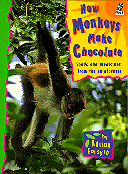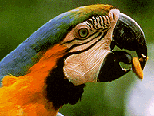


|
How Monkeys Make Chocolate: Foods and Medicines from the Rainforests.
Adrian Forsyth.
Grades 4 - 8 / Ages 8 - 13.
|
excerpt:
We still know very little about thousands of kinds of rainforest plants and animals. We don't even have names for many of them. But what goes on between all the plants and animals is what makes the forest work -- flowers are pollinated. seeds are spread, animals are fed. Little by little, we are learning to see and to use these connections. Without the relationship between monkeys and cacao. we would not have chocolate And living forests are full of riches yet to be found.

|
 The destruction of rainforests throughout the globe. and the resultant
loss of potential medicines and foods is not lost on young adults.
Circulation records at public and school libraries indicate that
elementary and high school students' interest in the topic is not simply
curriculum-driven. Adrian Forsyth's How Monkeys Make
Chocolate successfully explores four instances of the interaction
of plants, animals, and people in rainforests.
The destruction of rainforests throughout the globe. and the resultant
loss of potential medicines and foods is not lost on young adults.
Circulation records at public and school libraries indicate that
elementary and high school students' interest in the topic is not simply
curriculum-driven. Adrian Forsyth's How Monkeys Make
Chocolate successfully explores four instances of the interaction
of plants, animals, and people in rainforests.
|
Recommended with reservations.
Jennifer La Chapelle is the head of a multi-branch public library in
Ontario. In addition to an M.L.S., she holds degrees in Political
Science, English, and History.
To comment on this title or this review, send mail to cmeditor@mts.net
![]()
Copyright © 1995 the Manitoba Library Association.
Reproduction for personal use is permitted only if this copyright notice
is maintained. Any other reproduction is prohibited without permission.
Published by
The Manitoba Library Association
ISSN 1201-9364
 Go back to CM Welcome page
Go back to CM Welcome page
 Go back to Table of Contents for this Issue
Go back to Table of Contents for this Issue